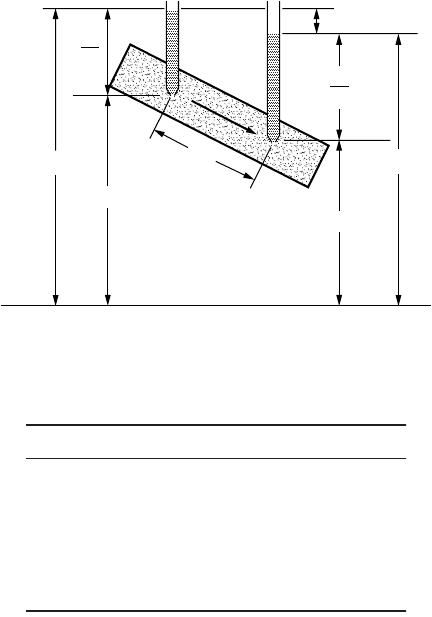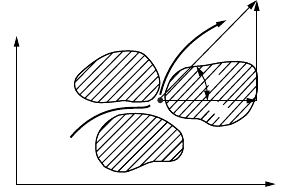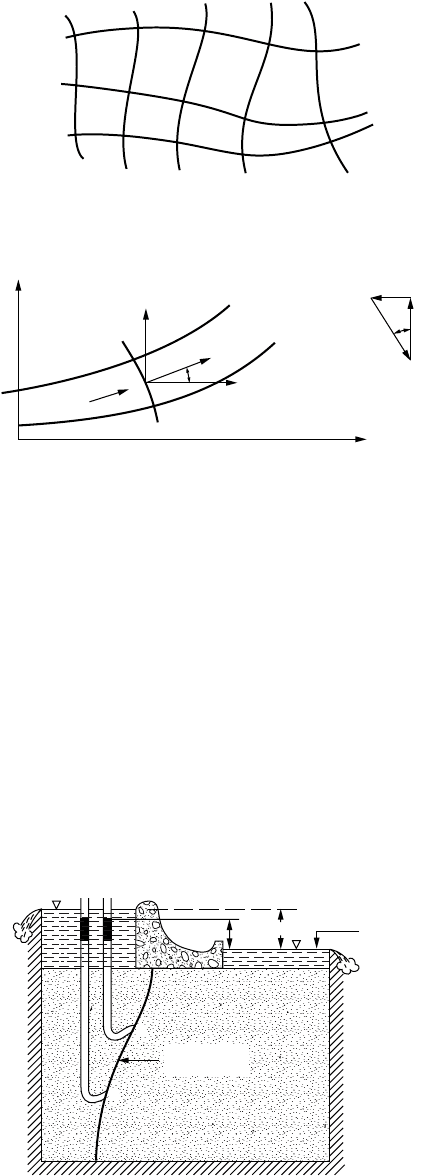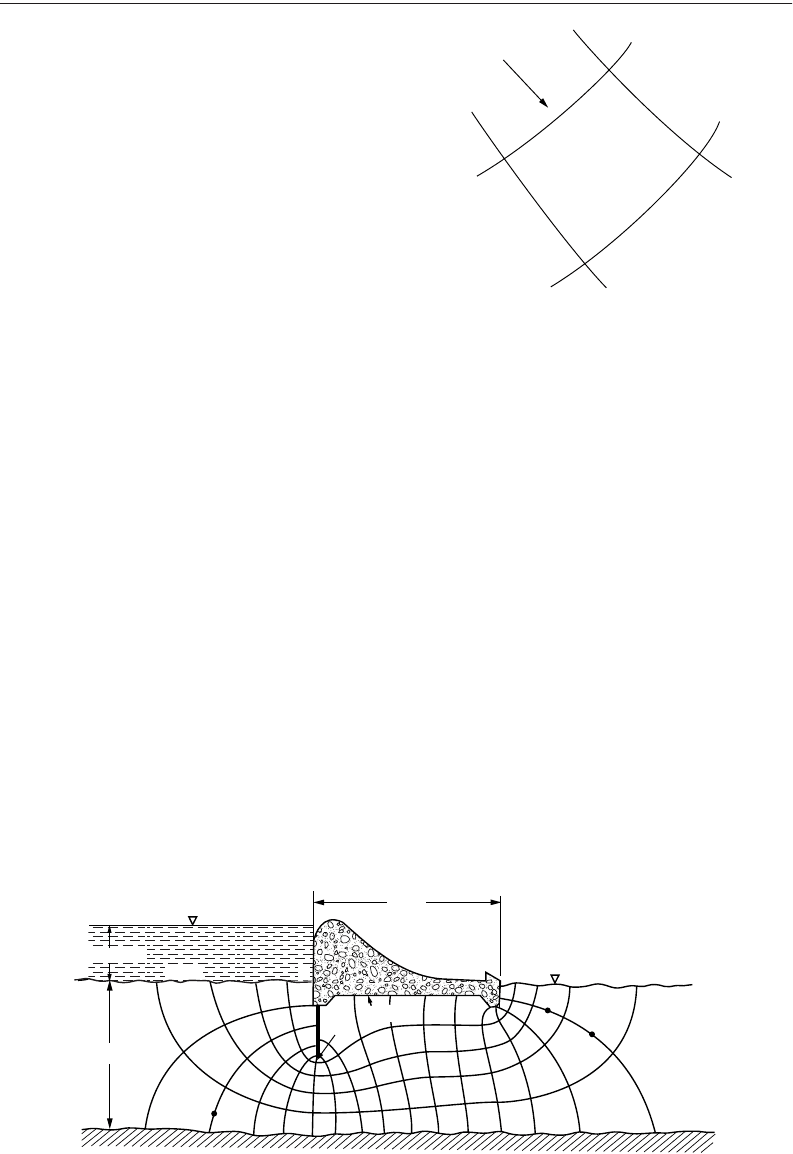Wai-Fah Chen.The Civil Engineering Handbook
Подождите немного. Документ загружается.

Mitchell, J. K. 1993. Fundamentals of Soil Behavior, 2nd ed. John Wiley & Sons, New York.
Oda, M. 1977. The mechanism of fabric changes during compressional deformation of sand. Soils Found.
12(2):1–18.
Saada, A. S., and Townsend, F. C. 1981. State of the art: In Laboratory strength testing of soils. In
Laboratory Shear Strength of Soil, Am. Soc. Test. Mater., Spec. Tech. Publ. 740: 7–77.
U. S. Army. 1970. Laboratory soils testing. Engineer Manual EM 1110-2-1906. Department of the Army,
Office of the Chief of Engineers, Washington, D.C.
Wong, K. S., and Duncan, J. M. 1974. Hyperbolic stress-strain parameters for non-linear finite element
analyses of stresses and movements in soil masses. Report TE 73-4. Department of Civil Engineering,
University of California, Berkeley.
Further Information
Holtz and Kovacs [1981], Lambe and Whitman [1969], and Mitchell [1993] are recommended for a
review of the fundamentals of the shear strength of soils.
Laboratory testing procedures are discussed in Head [1982, 1986], U.S. Army [1970], Lambe [1951], and
Bowles [1992] as well as the ASTM procedures referenced in Table 17.1.
Major conferences on the shear strength and deformation properties of soil include Research Conference
on Shear Strength of Cohesive Soils, ASCE, 1960; Laboratory Shear Testing of Soils, ASTM STP 361,
1964; Laboratory Shear Strength of Soil, STP 740, 1980; and Advanced Triaxial Testing of Soil and
Rock, ASTM STP 977, 1986.
Relevant state-of-the-art papers include Bjerrum [1973]; Ladd et al. [1977]; and Jamiolkowski et al.
[1985].
© 2003 by CRC Press LLC

© 2003 by CRC Press LLC
18
Groundwater
and Seepage
18.1 Introduction
18.2 Some Fundamentals
Bernoulli’s Equation
•
Darcy’s Law
•
Reynolds Number
•
Homogeneity and Isotropy
•
Streamlines and Equipotential
Lines
18.3 The Flow Net
18.4 Method of Fragments
18.5 Flow in Layered Systems
18.6 Piping
18.1 Introduction
Figure 18.1 shows the pore space available for flow in two highly idealized soil models:
regular cubic
and
rhombohedral
. It is seen that even for these special cases, the pore space is not regular, but consists of cavernous
cells interconnected by narrower channels. Pore spaces in real soils can range in size from molecular interstices
to cathedral-like caverns. They can be spherical (as in concrete) or flat (as in clays), or display irregular
patterns which defy description. Add to this the fact that pores may be
isolated
(inaccessible) or
interconnected
(accessible from both ends) or may be
dead-ended
(accessible through one end only).
In spite of the apparent irregularities and complexities of the available pores, there is hardly an
industrial or scientific endeavor that does not concern itself with the passage of matter, solid, liquid, or
gaseous, into, out of, or through porous media. Contributions to the literature can be found among such
diverse fields (to name only a few) as soil mechanics, groundwater hydrology, petroleum, chemical, and
metallurgical engineering, water purification, materials of construction (ceramics, concrete, timber,
paper), chemical industry (absorbents, varieties of contact catalysts, and filters), pharmaceutical industry,
traffic flow, and agriculture.
The flow of groundwater is taken to be governed by
Darcy’s law,
which states that the velocity of the
flow is proportional to the
hydraulic gradient
. A similar statement in an electrical system is
Ohm
’
s law
and in a thermal system,
Fourier’s law
. The grandfather of all such relations is
Newton’s laws of motion
.
Table 18.1 presents some other points of similarity.
18.2 Some Fundamentals
The literature is replete with derivations and analytical excursions of the basic equations of steady state
groundwater flow [e.g., Polubarinova-Kochina, 1962; Harr, 1962; Cedergren, 1967; Bear, 1972; Domenico
and Schwartz, 1990]. A summary and brief discussion of these will be presented below for the sake of
completeness.
Milton E. Harr
Purdue University

18
-2
The Civil Engineering Handbook, Second Edition
Bernoulli’s Equation
Underlying the analytical approach to groundwater flow is the representation of the actual physical system
by a tractable mathematical model. In spite of their inherent shortcomings, many such analytical models
have demonstrated considerable success in simulating the action of their prototypes.
As is well known from fluid mechanics, for steady flow of nonviscous incompressible fluids, Bernoulli’s
equation [Lamb, 1945]
(18.1)
FIGURE 18.1
Idealized void space.
TA BLE 18.1
Some Similarities of Flow Models
Form of Energy Name of Law Quantity Storage Resistance
Electrical Ohm’s law Current
(voltage)
Capacitor Resistor
Mechanical Newton’s law Force
(velocity)
Mass Damper
Thermal Fourier’s law Heat flow
(temperature)
Heat capacity Heat resistance
Fluid Darcy’s law Flow rate
(pressure)
Liquid storage Permeability
60°
90°
60°
(
a
)
(
c
)
(
e
)(
f
)
(
d
)
(
b
)
p
g
w
----- z
v
2
2g
-----++ cons ttan h==
© 2003 by CRC Press LLC

Groundwater and Seepage
18
-3
where
p
= pressure, lb/ft
2
g
w
= unit weight of fluid, lb/ft
3
–
v
= seepage velocity, ft/sec
g
= gravitational constant, 32.2 ft/s
2
h
= total head, ft
demonstrates that the sum of the
pressure head, p
/
g
w
,
elevation head, z
, and
velocity head,
–
v
2
/2
g
at any
point within the region of flow is a constant. To account for the loss of energy due to the viscous resistance
within the individual pores, Bernoulli’s equation is taken as
(18.2)
where
D
h
represents the total head loss (energy loss per unit weight of fluid) of the fluid over the distance
D
s
. The ratio
(18.3)
is called the
hydraulic gradient
and represents the space rate of energy dissipation per unit weight of fluid
(a pure number).
In most problems of interest the velocity heads (the kinetic energy) are so small they can be neglected.
For example, a velocity of 1 ft/s, which is large compared to typical seepage velocities through soils,
produces a velocity head of only 0.015 ft. Hence, Eq. (18.2) can be simplified to
and the total head at any point in the flow domain is simply
(18.4)
Darcy’s Law
Prior to 1856, the formidable nature of the flow through porous media defied rational analysis. In that
year, Henry Darcy published a simple relation based on his experiments on the flow of water in vertical
sand filters in “Les fontaines publiques de la ville de Dijon,” namely,
(18.5)
Equation (18.5), commonly called
Darcy’s law,
demonstrates a linear dependency between the hydraulic
gradient and the
discharge velocity v
. The discharge velocity,
v
=
nv
–
, is the product of the porosity
n
and
the seepage velocity,
–
v
. The coefficient of proportionality
k
is called by many names depending on its
use; among these are the
coefficient of permeability
,
hydraulic conductivity,
and
permeability constant.
As shown in Eq. (18.5),
k
has the dimensions of a velocity. It should be carefully noted that Eq. (18.5)
states that flow is a consequence of differences in total head and not of pressure gradients. This is
demonstrated in Fig. 18.2, where the flow is directed from
A
to
B
, even though the pressure at point
B
is
greater
than that at point
A.
p
A
g
w
----- z
A
v
A
2
2g
-----++
p
B
g
w
----- z
B
v
B
2
2g
----- hD++ +=
i
hD
sD
------
s 0ÆD
lim–
dh
ds
------–==
p
A
g
w
----- z
A
+
p
B
g
w
----- z
B
hD++=
h
p
g
w
----- z+=
vki k
dh
ds
------
–==
© 2003 by CRC Press LLC

18-4 The Civil Engineering Handbook, Second Edition
Defining Q as the total volume of flow per unit time through a cross-sectional area A, Darcy’s law
takes the form
(18.6)
Darcy’s law offers the single parameter k to account for both the characteristics of the medium and
the fluid. It has been found that k is a function of g
f
, the unit weight of the fluid, m, the coefficient of
viscosity, and n, the porosity, as given by
(18.7)
where C (dimensionally an area) typifies the structural characteristics of the medium independent of the
fluid properties. The principal advantage of Eq. (18.7) lies in its use when dealing with more than one
fluid or with temperature variations. When employing a single relatively incompressible fluid subjected
to small changes in temperature, such as in groundwater- and seepage-related problems, it is more
convenient to use k as a single parameter. Some typical values for k are given in Table 18.2.
Although Darcy’s law was obtained initially from considerations of one-dimensional macroscopic flow,
its practical utility lies in its generalization into two or three spatial dimensions. Accounting for the
directional dependence of the coefficient of permeability, Darcy’s law can be generalized to
(18.8)
FIGURE 18.2 Heads in Bernoulli’s equation.
TABLE 18.2 Some Typical Values of Coefficient
of Permeability
Soil Type Coefficient of Permeability k, cm/s
Clean gravel 1.0 and greater
Clean sand (coarse) 1.0–0.01
Sand (mixtures) 0.01–0.005
Fine sand 0.05–0.001
Silty sand 0.002–0.0001
Silt 0.0005–0.00001
Clay 0.000001 and smaller
p
A
g
w
p
B
g
w
∆
s
∆
h
h
A
z
A
z
B
h
B
A
B
Arbitrary datum
QAvAki Ak
dh
ds
------
–== =
kC
g
f
n
m
---------
=
v
s
k
s
h
∂
s
∂
------
–=
© 2003 by CRC Press LLC
Groundwater and Seepage 18-5
where k
s
is the coefficient of permeability in the s direction, and v
s
and ∂ h/∂ s are the components of the
velocity and the hydraulic gradient, respectively, in that direction.
Reynolds Number
There remains now the question of the determination of the extent to which Darcy’s law is valid in actual
flow systems through soils. Such a criterion is furnished by the Reynolds number R (a pure number
relating inertial to viscous force), defined as
(18.9)
where v = discharge velocity, cm/s
d = average of diameter of particles, cm
r = density of fluid, g(mass)/cm
3
m = coefficient of viscosity, g-s/cm
2
The critical value of the Reynolds number at which the flow in aggregations of particles changes from
laminar to turbulent flow has been found by various investigators [see Muskat, 1937] to range between
1 and 12. However, it will generally suffice to accept the validity of Darcy’s law when the Reynolds number
is taken as equal to or less than unity, or
(18.10)
Substituting the known values of r and m for water into Eq. (18.10) and assuming a conservative
velocity of 1/4 cm/s, we have d equal to 0.4 mm, which is representative of the average particle size of
coarse sand.
Homogeneity and Isotropy
If the coefficient of permeability is independent of the direction of the velocity, the medium is said to
be isotropic. Moreover, if the same value of the coefficient of permeability holds at all points within the
region of flow, the medium is said to be homogeneous and isotropic. If the coefficient of permeability
depends on the direction of the velocity and if this directional dependence is the same at all points of
the flow region, the medium is said to be homogeneous and anisotropic (or aleotropic).
Streamlines and Equipotential Lines
Physically, all flow systems extend in three dimensions. However, in many problems the features of the
motion are essentially planar, with the flow pattern being substantially the same in parallel planes. For
these problems, for steady state, incompressible, isotropic flow in the xy plane, it can be shown [Harr,
1962] that the governing differential equation is
(18.11)
Here the function h(x, y) is the distribution of the total head (of energy to do work), within and on
the boundaries of a flow region, and k
x
and k
y
are the coefficients of permeability in the x and y directions,
respectively. If the flow system is isotropic, k
x
= k
y
, and Eq. (18.11) reduces to
(18.12)
R
vd
r
m
----------=
vd
r
m
----------
1£
k
x
h
2
∂
x
2
∂
---------
k
y
h
2
∂
y
2
∂
---------
0==
h
2
∂
x
2
∂
---------
h
2
∂
y
2
∂
---------+ 0=
© 2003 by CRC Press LLC
18-6 The Civil Engineering Handbook, Second Edition
Equation (18.12), called Laplace’s equation, is the governing relationship for steady state, laminar-flow
conditions (Darcy’s law is valid). The general body of knowledge relating to Laplace’s equation is called
potential theory. Correspondingly, incompressible steady state fluid flow is often called potential flow. The
correspondence is more evident upon the introduction of the velocity potential f, defined as
(18.13)
where h is the total head, p/g
w
is the pressure head, z is the elevation head, and C is an arbitrary constant.
It should be apparent that, for isotropic conditions,
(18.14)
and Eq. (18.12) will produce
(18.15)
The particular solutions of Eqs. (18.12) or (18.15) that yield the locus of points within a porous
medium of equal potential, curves along which h(x, y) or f(x, y) are equal to constants, are called
equipotential lines.
In analyses of groundwater flow, the family of flow paths is given by the function y(x, y), called the
stream function, defined in two dimensions as [Harr, 1962]
(18.16)
where v
x
and v
y
are the components of the velocity in the x and y directions, respectively.
Equating the respective potential and stream functions of v
x
and v
y
produces
(18.17)
Differentiating the first of these equations with respect to y and the second with respect to x and
adding, we obtain Laplace’s equation:
(18.18)
We shall examine the significance of this relationship following a little more discussion of the physical
meaning of the stream function. Consider AB of Fig. 18.3 as the path of a particle of water passing through
point P with a tangential velocity v. We see from the figure that
and hence
(18.19)
f
xy,() kh– C+ k
p
g
w
----- z+
˯
ʈ
– C+==
v
x
f
∂
x
∂
-------
v
y
f
∂
y
∂
-------==
—
2
f
f
2
∂
x
2
∂
---------
f
2
∂
y
2
∂
---------+ 0==
v
x
y
∂
y
∂
-------
v
y
y
∂
x
∂
-------–==
f∂
x
∂
------
y∂
y
∂
-------
f∂
y
∂
------
y∂
x
∂
-------–==
y
2
∂
x
2
∂
---------
y
2
∂
y
2
∂
---------+ 0=
v
y
v
x
----
q
tan
dy
dx
------==
v
y
dx v
x
dy– 0=
© 2003 by CRC Press LLC

Groundwater and Seepage 18-7
Substituting Eq. (18.16), it follows that
which states that the total differential d y = 0 and
Thus we see that the family of curves generated by the function y(x, y) equal to a series of constants
are tangent to the resultant velocity at all points in the flow region and hence define the path of flow.
The potential [f = – kh + C] is a measure of the energy available at a point in the flow region to move
the particle of water from that point to the tailwater surface. Recall that the locus of points of equal
energy, say, f(x, y) = constants, are called equipotential lines. The total differential along any curve
f(x, y) = constant produces
Substituting for ∂f/∂x and ∂f /∂y from Eqs. (18.16), we have
and
(18.20)
Noting the negative reciprocal relationship between their slopes, Eqs. (18.19) and (18.20), we see that,
within the flow domain, the families of streamlines y (x, y) = constants and equipotential lines f (x, y) =
constants intersect each other at right angles. It is customary to signify the sequence of constants by
employing a subscript notation, such as f(x, y) = f
i
, y(x, y) = y
j
(Fig. 18.4).
As only one streamline may exist at a given point within the flow medium, streamlines cannot intersect
one another. Consequently, if the medium is saturated, any pair of streamlines act to form a flow channel
between them. Consider the flow between the two streamlines y and y + dy in Fig. 18.5; v represents
the resultant velocity of flow. The quantity of flow through the flow channel per unit length normal to
the plane of flow (say, cubic feet per second per foot) is
FIGURE 18.3 Path of flow.
B
n
y
n
x
A
0
P
q
v
y
x
y
∂
x
∂
-------
dx
y
∂
y
∂
-------
dy+ 0=
y
xy,()cons ttan=
d
f
f∂
x
∂
------
dx
f∂
y
∂
------
dy+ 0==
v
x
dx v
y
dy+ 0=
dy
dx
------
v
x
v
y
----–=
dQ v
x
ds
q
v
y
ds
q
sin–cos v
x
dy v
y
dx–
y∂
y
∂
-------
dy
y∂
x
∂
-------
dx+===
© 2003 by CRC Press LLC

18-8 The Civil Engineering Handbook, Second Edition
and
(18.21)
Hence the quantity of flow (also called the discharge quantity) between any pair of streamlines is a
constant whose value is numerically equal to the difference in their respective y values. Thus, once a
sequence of streamlines of flow has been obtained, with neighboring y values differing by a constant
amount, their plot will not only show the expected direction of flow but the relative magnitudes of the
velocity along the flow channels; that is, the velocity at any point in the flow channel varies inversely
with the streamline spacing in the vicinity of that point.
An equipotential line was defined previously as the locus of points where there is an expected level of
available energy sufficient to move a particle of water from a point on that line to the tailwater surface.
Thus, it is convenient to reduce all energy levels relative to a tailwater datum. For example, a piezometer
located anywhere along an equipotential line, say at 0.75h in Fig. 18.6, would display a column of water
extending to a height of 0.75h above the tailwater surface. Of course, the pressure in the water along the
equipotential line would vary with its elevation.
FIGURE 18.4 Streamlines and equipotential lines.
FIGURE 18.5 Flow between streamlines.
FIGURE 18.6 Pressure head along equipotential line.
y
1
y
2
y
3
f
5
f
4
f
3
f
2
f
1
y
x
dx
ds
dy
q
q
n
x
y +
d
y
y
n
n
y
dQ
0
dQ d
y
=
Tailwater
datum
0.75
h
h
b
a
Equipotential
line, 0.75
h
© 2003 by CRC Press LLC

Groundwater and Seepage 18-9
18.3 The Flow Net
The graphical representation of special members of the
families of streamlines and corresponding equipotential
lines within a flow region form a flow net. The orthogonal
network shown in Fig. 18.4 represents such a system.
Although the construction of a flow net often requires
tedious trial-and-error adjustments, it is one of the more
valuable methods employed to obtain solutions for two-
dimensional flow problems. Of additional importance,
even a hastily drawn flow net will often provide a check on
the reasonableness of solutions obtained by other means.
Noting that, for steady state conditions, Laplace’s equation
also models the action (see Table 18.1) of thermal, electri-
cal, acoustical, odoriferous, torsional, and other systems,
the flow net is seen to be a significant tool for analysis.
If, in Fig. 18.7, Dw denotes the distance between a pair
of adjacent streamlines and Ds is the distance between a pair of adjacent equipotential lines in the near
vicinity of a point within the region of flow, the approximate velocity (in the mathematical sense) at the
point, according to Darcy’s law, will be
(18.22)
As the quantity of flow between any two streamlines is a constant, DQ, and equal to Dy (Eq. 18.21)
we have
(18.23)
Equations (18.22) and (18.23) are approximate. However, as the distances Dw and Ds become very
small, Eq. (18.22) approaches the velocity at the point and Eq. (18.23) yields the quantity of discharge
through the flow channel.
In Fig. 18.8 is shown the completed flow net for a common type of structure. We first note that there
are four boundaries: the bottom impervious contour of the structure BGHC, the surface of the impervious
layer EF, the headwater boundary AB, and the tailwater boundary CD. The latter two boundaries
designate the equipotential lines h = h and h = 0, respectively. For steady state conditions, the quantity
FIGURE 18.8 Example of flow net.
FIGURE 18.7 Flow at point.
B
D
C
A
h
h
+ ∆
h
y + ∆
y
∆
s
∆
Q
∆
w
y
v
khD
sD
----------
y
D
wD
-------
ªª
Qk
wD
sD
-------
hDªD
60 ft
C
D
h
= 0
1
3
F
G
H
2
E
50 ft
h
=
h
1
h
2
h
3
y
BGHC
y
EF
A
h
= 16 ft
h
=
h
B
© 2003 by CRC Press LLC
